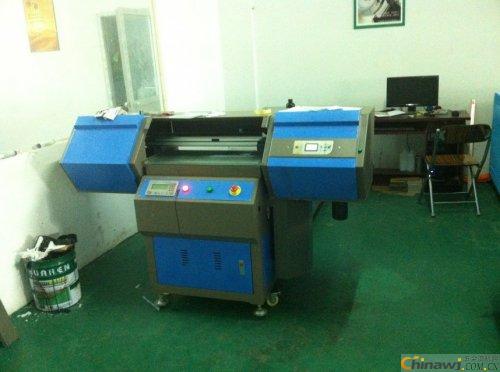Dongguan New Thinking Digital Color Printing Equipment Co., Ltd. is a professional manufacturer and supplier of advanced digital printing solutions, including universal flatbed printers, multi-purpose inkjet printers, flatbed digital color printers, leather printing machines, glass printing systems, and ceramic tile as well as stainless steel color printing equipment. These high-performance devices are widely used in the decoration and manufacturing industries for efficient and precise printing on various surfaces.
The ceramic inkjet printing process involves several key steps to ensure optimal results:
1. **Cleaning the Tile**: Begin by thoroughly cleaning the ceramic tile to remove any dust, grease, or contaminants that may affect print quality.
2. **Spray Coating (Varnish Application)**:
- The coating mixture consists of 2 parts varnish, 1 part thinner, and 1 part Guhua.
- The varnish ratio should be mixed as 2 parts varnish, 1 part curing agent, and 1 part thinner.
- The recommended mixing ratio is varnish : curing agent : thinner = 2:1:1.
- The coating must be filtered through a 300-mesh cloth at least once or up to three times to remove impurities.
- When applying the spray, ensure the oil ratio is correct and the tile is clean and free of debris.
- Use a large-mouth spray gun (model W-7) for even coverage.
- After spraying, allow the coating to rest flat for 10–20 minutes to level out before proceeding with printing.
- The coating should be applied within 0.25 to 0.5 hours; any unused coating must be discarded to prevent degradation.
3. **Printing**:
- Before starting, check the nozzle to confirm the printer is discharging ink properly.
- Ensure the coated surface is smooth, clean, and free of imperfections.
- Turn on the air conditioner to maintain an environment with a temperature below 23°C and humidity under 75%.
- After printing, inspect the glass for issues such as white spots, ink scattering, streaking, or color inconsistency.
4. **Baking**:
- Once printing is complete, let the tile sit for at least 5 minutes before baking. If the air conditioner is running, it can be left for up to 30 minutes.
- Baking is typically done at 130°C for 10 minutes.
- Alternatively, bake at 180°C for 5–10 minutes or at 100°C for 10–20 minutes depending on the desired finish.
- Natural drying usually takes between 2 to 4 hours to fully cure.
For more information about ceramic inkjet printing technology and equipment, visit [http://news.chinawj.com.cn](http://news.chinawj.com.cn).
 Submission:
Submission: 
 Submission:
Submission: 
Aluminum doors are doors with aluminum alloy as the frame and inlaid glass. The following is its relevant introduction:
1. Structural composition
Aluminum alloy frame
The aluminum alloy frame provides a stable support structure for aluminum doors. Aluminum alloy has the advantages of high strength, light weight, and corrosion resistance. Its profiles can be made into various shapes and sizes according to different design requirements, such as common squares, rectangles, etc., and can be anodized, powder sprayed and other surface treatments to achieve beautiful and durable effects.
Glass part
Glass is an important part of aluminum doors, with functions such as lighting and transparent vision. According to different needs, ordinary transparent glass, frosted glass, tempered glass, hollow glass, etc. can be selected.
Ordinary transparent glass has good light transmittance, but its safety and heat insulation and sound insulation performance are relatively poor. Frosted glass can protect privacy to a certain extent and is suitable for places with certain privacy requirements, such as bathrooms. Tempered glass has high strength, blunt-angle particles after breaking, good safety, and is often used in public places or places with high safety requirements. Hollow glass has better heat insulation and sound insulation performance, and is suitable for places where the indoor environment needs to be kept comfortable.
2. Types
Sliding aluminum door
This type of door uses tracks and pulleys to push and pull the door leaf left and right. Its advantages are space saving and easy operation. It is suitable for places with small space or not suitable for swing door opening, such as partitions between balconies and indoor areas, entrances and exits of small shops, etc. However, the sealing performance of sliding aluminum doors is relatively weak, and it may not be as good as swing doors in terms of sound insulation, heat insulation and preventing dust from entering.
Swing aluminum door
Swing aluminum doors are connected by hinges and can be opened inward or outward. It has good sealing performance and can effectively block dust, rain, noise, etc. from the outside. The safety of swing doors is also high, and they are suitable as entrance doors for residential buildings or partition doors between indoor rooms. However, swing aluminum doors need to occupy a certain space when opened, and have certain requirements for the surrounding space.
3.Advantages
Aesthetics: The transparency of the glass of the aluminum glass door can make the space appear more open and bright, and has a high decorative value.
Strong and durable: The aluminum alloy material has high strength and is not easy to deform, which can ensure the long-term use of the door.
Good sealing: The aluminum glass door can effectively block the dust, noise and temperature changes from the outside.
Corrosion resistance: The aluminum glass door can adapt to different environmental conditions and is not easy to rust.
In commercial places such as shopping malls and office buildings, aluminum glass doors are often used in storefronts, office partitions, etc.; in homes, they are also commonly seen in areas such as balcony doors and kitchen doors.
aluminum door bathroom,aluminum kitchen doors, Aluminium Bifold Doors,Aluminium Corner Doors , Aluminium Sliding Doors
SMIRO DOORS AND WINDOWS CO., LTD , https://www.smirowindows.com